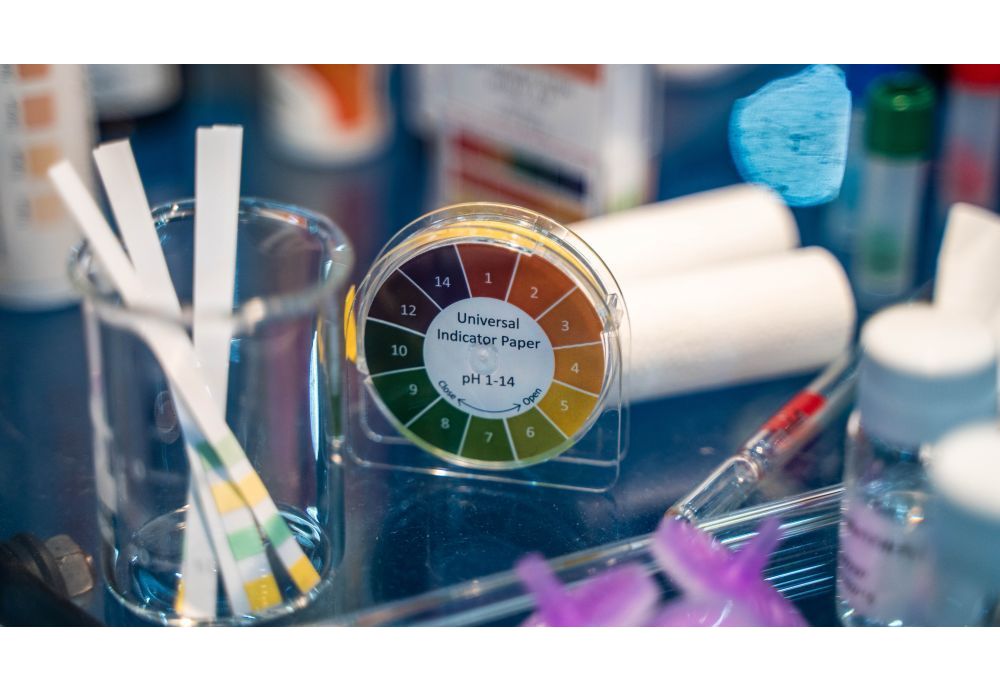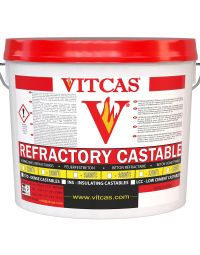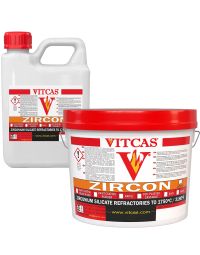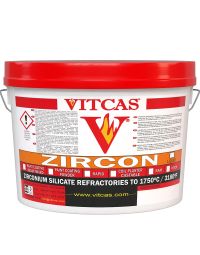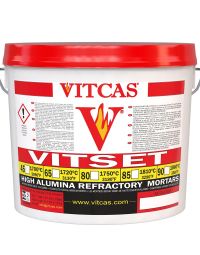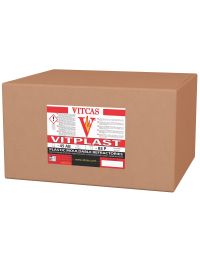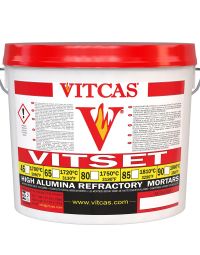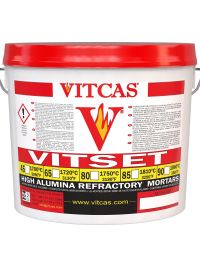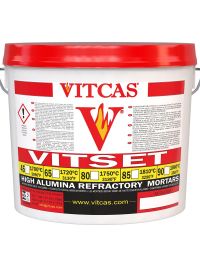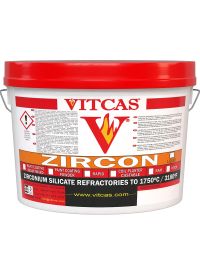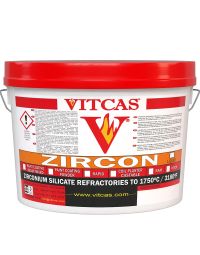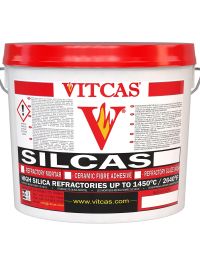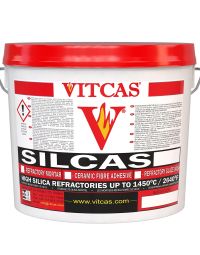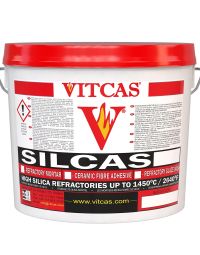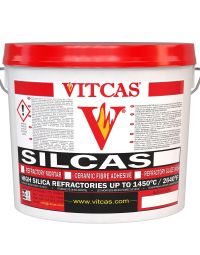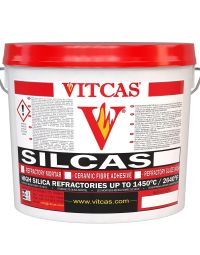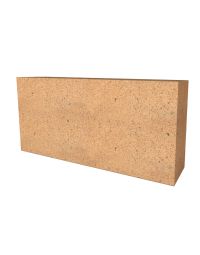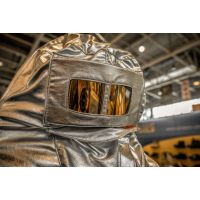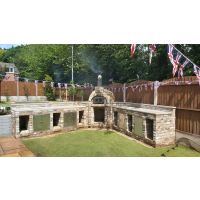Refractories play a critical role in industries that operate under extreme temperature conditions, such as steelmaking, cement manufacturing and glass production. Refractory materials are classified based on several factors, one of the most fundamental being their chemical composition. This classification impacts the performance of the refractories and determines their suitability for specific applications. As a leading manufacturer of refractory solutions, Vitcas offers a wide range of products tailored to meet the unique requirements of acidic, neutral and basic refractory applications.
Acidic Refractories
Acidic refractories are primarily composed of acidic materials such as alumina (Al₂O₃), silica (SiO₂), and zircon. Common acidic refractories include:
- Pure silica refractories
- Alumino-silicate refractories
- Fire clay bricks (chamotte bricks)
- Zircon refractories
Vitcas offers a range of acidic refractory products:
- Vitcas Silcas A and Silcas M: Ready-mixed, smooth refractory mortars ideal for setting and jointing fire bricks in kilns, furnaces and other high-temperature acidic applications. With a temperature rating of 1400°C (2550°F), they are a robust choice for aluminosilicate-based environments.
- Vitcas Premium Fire Cement: A finely ground, heat-resistant cement designed for use in acidic environments. It is ideal for sealing and repairing cracks in ovens, stoves, and fireplaces, withstanding temperatures up to 1250°C (2280°F).
- Vitcas Zircon range: Zircon-based materials range from Zircon Refractory Paint Coating to Zircon Coil Plaster Castable.
- Fire bricks: Vitcas fire bricks are high-alumina, heat-resistant bricks designed for kilns, furnaces and fireplaces. They offer excellent thermal stability and durability in acidic, high-temperature environments.
Acidic refractories are well-suited for most acidic environments and are commonly used in applications where exposure to basic (alkaline) materials is avoided, as they tend to react with such substances at high temperatures.
Notable acidic reagents that can attack or affect both alumina and silica are:
- Hydrofluoric acid
- Phosphoric acid
- Fluorinated gases (e.g. HF, F2)
Notable alkaline (basic) reagents that can attack acidic refractories are:
- Lime (Calcium oxide- CaO): Lime is a strongly basic oxide that readily reacts with acidic materials such as silica (SiO₂). At elevated temperatures, CaO forms low-melting calcium silicates, which can compromise the structural integrity of silica-based refractories. This makes lime highly reactive and unsuitable for contact with acidic linings.
- Ordinary Portland Cement (OPC): Its alkalinity is due to its hydration process which produces calcium hydroxide (Ca(OH)₂). This high alkalinity protects embedded steel reinforcement from corrosion but can also cause reactions with acidic substances, leading to degradation in highly acidic environments.
- Magnesia (Magnesium oxide- MgO): Magnesia is another strongly basic oxide used in refractory applications, especially in metallurgical furnaces. It reacts with acidic oxides like silica (SiO₂) to form magnesium silicates, such as MgSiO₃, which can be detrimental to refractory performance due to the formation of low-melting or structurally weak phases. For this reason, magnesia-based refractories are not recommended for use with acidic materials unless an intermediate or neutral lining is applied.
N.B. Pure materials typically exhibit higher melting points, whereas compounds and mixtures generally melt at lower temperatures. This is because pure substances consist of a uniform arrangement of identical particles-atoms, ions or molecules-which form well-defined crystal lattices. These strong, orderly bonds require substantial thermal energy to break, resulting in higher melting points.
In contrast, compounds and mixtures, especially those with multiple oxides or impurities, disrupt the regular crystal structure. This leads to weakened bonding and the formation of eutectic systems, which melt at temperatures lower than any of the individual components. In refractory materials, for instance, the presence of fluxing agents like alkali oxides (Na₂O, K₂O) or iron oxides (Fe₂O₃) can significantly lower the melting point and compromise the thermal stability.
Applications of acidic refractory materials
Due to the high silica (SiO₂) or alumina (Al₂O₃) content of most acidic refractories and their resistance to acidic slags, they have applications in the following industries:
Glass Manufacturing: Silica bricks in regenerator chambers of glass furnaces.
Coke Ovens: Silica bricks for lining due to resistance to acidic by-products.
Ceramic Kilns: Fire clay bricks for kiln linings and supports.
Chimneys and Flue Linings: Acid-resistant bricks in structures exposed to acidic gases.
Neutral Refractories
Neutral refractories exhibit stability in both acidic and basic environments, making them versatile for a wide range of applications. The main raw materials belong to, but are not confined to, the R2O3 group. Their chemical stability makes them ideal for use in environments where the slag or atmosphere fluctuates between acidic and basic.
These refractories are typically composed of materials such as:
- Alumina (Al₂O₃)
- Chromium oxide (Cr₂O₃)
- Ferric oxide (Fe₂O₃)
- Carbon
For applications requiring neutral refractories, Vitcas offers:
- Vitset 45 and Vitset 90: High-alumina refractory mortars that provide excellent resistance to both acidic and basic atmospheres. With temperature resistances of up to 1700°C (3100°F), these mortars are ideal for setting dense and insulating refractory bricks.
- Vitcas CFA Ceramic Fibre Adhesive: Perfect for bonding ceramic fibre blankets and boards in environments where chemical neutrality is required.
- Refractory Castables: Alumina-based refractory castables provide excellent thermal shock resistance and abrasion resistance, making them ideal for lining furnaces, incinerators, and areas subjected to rapid temperature fluctuations or mechanical wear.
Applications of neutral refractory materials
Neutral refractories that are made of primarily alumina (Al₂O₃), chromite (FeCr₂O₄) and carbon, offer resistance to both acidic and basic slags. They are best suited for the following applications:
Steel Industry: Alumina bricks are suitable in electric arc furnace roofs and ladles. Whereas, chromite bricks are suited for use in rotary kilns and non-ferrous metal smelting.
Cement Kilns: High-alumina refractories for zones exposed to both basic and acidic reactions.
Chemical Industry: Graphite crucibles for handling molten metals and corrosive chemicals.
Basic Refractories
Basic refractories are characterised by the predominance of oxides such as MgO and related compounds. These materials are referred to as "basic" due to their chemical behaviour; they react with water to form hydroxides, which are classified as bases. While these refractories are generally alkaline, some of the materials exhibit nearly neutral chemical properties.
Basic refractories are specifically designed for use in highly alkaline environments, such as cement kilns and steel ladles. They are highly resistant to alkaline (basic) slags and atmospheres but are susceptible to degradation when exposed to acidic conditions. These refractories are composed of raw materials that primarily belong to the RO group, which includes divalent metal oxides. Common examples include:
- Magnesia (MgO): Widely used for lining steel ladles, typically in the form of magnesite bricks.
- Dolomite (MgO-CaO): A double oxide of magnesium and calcium, often used in basic oxygen furnaces and steel ladle linings.
- Chrome-magnesia: A combination of Cr₂O₃ and MgO, offering excellent corrosion resistance to basic slags.
- Chromite (FeCr₂O4): A chromium-rich spinel, commonly used as a raw material for magnesia-chrome refractories.
- Picrochromite (MgCr₂O4): A natural magnesium-chromium spinel, with limited industrial use but significant structural similarities to synthetic magnesia-chrome materials.
- Spinel (MgAl₂O4): A magnesium-aluminum oxide known for its excellent thermal stability and resistance to chemical attack.
- Forsterite (Mg₂SiO4): A magnesium silicate, primarily used in specialised refractory applications where moderate refractoriness and chemical stability are required.
Vitcas provides tailored solutions for basic refractory applications:
- Vitplast 45AB: A plastic mouldable refractory that is highly resistant to alkaline materials and is widely used in steel and cement industries for quick repairs of refractory linings.
- Vitcas HB60: A heat-resistant adhesive suitable for constructing stoves, pizza ovens and tiled stoves. Its high heat resistance (up to 750°C/1380°F) and compatibility with alkaline conditions make it an excellent choice for outdoor and industrial applications.
Resistance of basic refractories to acids
Historically, magnesia and dolomite bricks, which have been in use since the late 19th century, have shown vulnerabilities to thermal shocks and acidic slag attacks. To address these challenges, several measures have been implemented:
- Oxide Additives: The inclusion of oxides such as magnesia-chromite, magnesia-spinel, magnesia-zirconia, magnesia-hercynite and magnesia-galaxite enhances the bricks' stress endurance and wear resistance.
- Carbon Inclusion: Adding carbon to the brick structure minimises infiltration, thereby preserving resistance to thermal and mechanical stress. This is particularly effective when carbon is concentrated near the hot face of the bricks.
Applications of basic refractory materials
The high magnesia (MgO) or dolomite (CaO·MgO) content offers excellent resistance to basic slags, which makes them suitable for the following industrial applications:
- Steelmaking: Magnesia bricks are well suited for basic oxygen furnaces (BOF) and electric arc furnaces (EAF). When it comes to dolomite bricks, they can be used in converters and ladles for desulfurization.
- Cement and Lime Production: Magnesite refractories in rotary kilns.
- Glass Furnaces: Magnesia-chrome bricks for areas exposed to alkalis.
- Non-Ferrous Metallurgy: Linings for furnaces processing copper and nickel.
Distinction Between Burnt/Dead and Fused Alkaline Refractories
Alkaline refractories, primarily composed of magnesia (MgO) or dolomite (CaO·MgO), are widely used in high-temperature industrial applications due to their excellent resistance to basic slags. These refractories are manufactured using two primary methods: burning (dead burning) and fusing, each with distinct production processes, properties and applications.
Burnt (Dead Burnt) Basic Refractories
Burnt or dead burnt refractories are produced by calcining raw materials (e.g., magnesite or dolomite) at extremely high temperatures, typically between 1400°C/2550°F and 2000°C/3630°F. During calcination, the material undergoes decomposition and sintering, forming a dense, stable and chemically inert structure.
Dead burnt or burnt basic refractories are characterised by their high bulk density and low porosity, offering excellent thermal stability and resistance to hydration in high-temperature environments. Their mechanical strength is moderate compared to fused basic refractories and they are comparatively more susceptible to abrasion.
Burnt and dead burnt refractories are widely used for linings in basic oxygen furnaces (BOF) and electric arc furnaces (EAF) in the steel industry. They are also utilised in rotary kilns for cement and lime production and in areas requiring resistance to basic slags and fluxes.
Fused Alkaline Refractories
Fused refractories are produced by melting raw materials in an electric arc furnace at temperatures exceeding 3000°C/5430°F. The molten material is then cooled and solidified, often cast into moulds or crushed into grains for further processing. The process results in crystalline and glassy phases, giving the material unique properties.
Fused basic refractories are known for their extremely high density and low porosity, which result in superior mechanical strength, abrasion resistance and thermal shock resistance. Their high purity and chemical stability are achieved through the removal of impurities during the melting process, enhancing their resistance to slag penetration and chemical attack.
These properties make fused basic refractories ideal for high-performance linings in steel ladles, tundishes and other critical areas in the steelmaking process. They are also extensively used in glass furnaces and environments exposed to aggressive slags and alkalis, as well as in applications requiring exceptional resistance to mechanical wear and chemical erosion.
Key Considerations
When selecting refractories, it is essential to ensure compatibility between acidic, neutral and basic materials. As a general rule:
- Avoid contact between acidic and basic refractories at high temperatures to prevent chemical reactions that could compromise their integrity.
- Use neutral refractories when versatility is required in fluctuating environments.
Conclusion
Understanding the chemical composition of refractories is critical for selecting the right materials for high-temperature industrial processes. Vitcas offers a diverse portfolio of refractory products designed to meet the needs of acidic, neutral and basic environments. From Silcas A for acidic applications to HB60 for basic environments, Vitcas ensures durability, performance and efficiency in every product.
Explore our comprehensive range of refractory solutions and ensure your operations are equipped with materials tailored for their specific challenges.






